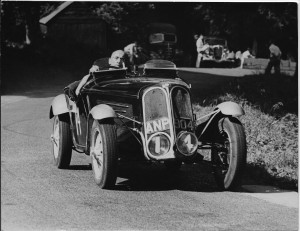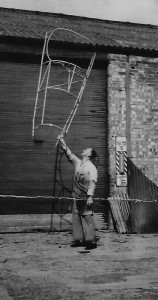
It was about this time that Willis engaged the help of his son-in-law, Charles Bulmer to help with his next series of modifications. Bulmer was working in scientific research at Royal Aircraft Establishment (RAE), in Farnborough. He had met, and become engaged to Heather Logsdon, who was the daughter of Hazel Willis. While Willis provided the practical and creative spark, Bulmer provided the formal engineering and research support necessary to develop the car.
We can measure the effects these improvements were having on the performance of the car by comparing Willis’ times at the BOC Prescott Hillclimb over these years. In his first try in June of 1946, with the car completely stock, his time was 62.5 seconds. By the June event in 1947, with the new fenders, windscreen, and the headlights tucked into the radiator, he improved his time to 54.36 seconds.
Later that summer Willis and Bulmer took the car to its first circuit race, the Ulster Trophy Handicap race in Dunrod, Ireland. The car only lasted 2 laps succumbing to a failed bearing in the engine. This necessitated an engine rebuild, and Willis took advantage of the opportunity to extensively modifying the stock engine. The compression ratio was raised to more that 9:1, and the inlet breathing was improved by replacing the long head bolts that went through the middle of the inlet ports with Allen screws that were relieved flush with the bottom of the intake ports.
With Bulmer’s help Willis also developed a cast magnesium wheels for the car that saved about 12-15 lbs. of unsprung weight at each corner. These wheels became so successful that he was able to sell sets to many of his competitors running 328s and other BMW based specials during that era, including Oscar Moore’s OBM Special.
1948 was not a good year for motorsports in England. The meager gas ration alowed in 1947 was ended completely. This made competing difficult. The one highlight for that year was Bulmer’s first opportunity to drive the car. He wrote of that experience some 57 years later, “I drove the BMW for the first time, and I was captivated by it. The car had unfamiliar, to me, features, like a stiff chassis, springs which moved, and a smooth, high revving, rubber mounted six-cylinder engine. I began to think that my Meadows Nash might have to be replaced by a Type 55 BMW, which it was the following year.”

Willis took the lull in competition to rework the car completely, and when it reappeared in 1949, it looked entirely different. The engine and chassis remained unchanged but the steel BMW body had been replaced with a lightweight body of magnesium tubing and magnesium sheet. The cycle wings and headlights were made to be quickly removable so the car could run in both sports car and formula classes at the same race weekend.
The car now weighed just over 1100 lbs, and Willis found it necessary to remove every other leaf spring in the rear suspension to improve handling. The brakes were also given attention. They were converted to hydraulic operation, and fitted with finned light alloy drums. The lighter weight, coupled with better handling made the brakes very effective for that day.
These changes were a major effort and expense for Willis, but once the car was sorted the gains that he made were noticeable. At the Prescott Hillclimb in June of that year Willis finished second in class to a full race HRG with his time now down to 52.12 seconds, fully 10 seconds quicker than his first effort. At the Gosport Sprint event in October Willis turned a time of 17.95 seconds in the quarter mile.
